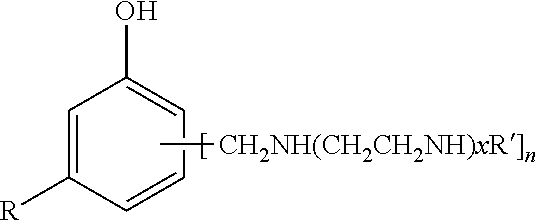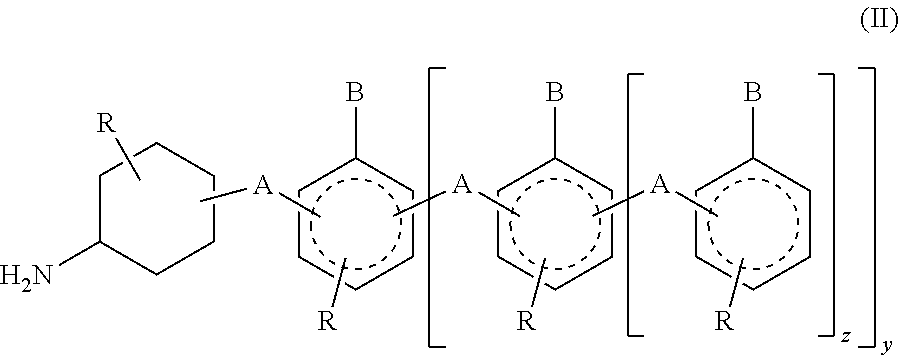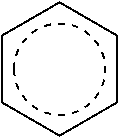Phenalkamine epoxy curing agents from methylene bridged poly(cyclohexyl-aromatic) amines and epoxy resin compositions containing the same
a technology of cyclohexylaromatic and phenalkamine, which is applied in the direction of epoxy resin adhesives, adhesive types, coatings, etc., can solve the problem of inability to easily control the molecular weight distribution of these products, and achieve the effect of high gloss and clarity
- Summary
- Abstract
- Description
- Claims
- Application Information
AI Technical Summary
Benefits of technology
Problems solved by technology
Method used
Image
Examples
example 1
of the Phenalkamine of MPCA with Molar Ratio of Cardanol:MPCA:Formaldehyde (1:1:1)
[0057]A 3-neck 1 L round bottom flask equipped with N2 inlet, addition funnel and temperature probe was charged with cardanol (298 g, 1.0 mole) and MPCA (350 g, 1.0 mole). The mixture was heated to 80° C. A 37% solution of formaldehyde (81 g, 37 wt. %, 30 g, 1.0 mole) was added to maintain a reaction temperature of 80-90° C. After the addition, the mixture was kept at 90-95° C. for 1 h. Water was distilled at 120° C. and the product was obtained as a light brown liquid. This product was cooled to ambient temperature and treated with 2,4,6-tri(dimethylaminomethyl)phenol (34.7 g) and benzyl alcohol (173 g). The resultant product had a viscosity of 5,710 mPa·s @ 23° C. and a theoretical AHEW of 150 g / eq.
example 2
of the Phenalkamine of MPCA with Molar Ratio of Cardanol:MPCA:Formaldehyde (1:1.5:1.0)
[0058]A 3-neck 1 L round bottom flask equipped with N2 inlet, addition funnel and temperature probe was charged with cardanol (298 g, 1.0 mole) and MPCA (525 g, 1.50 mole). The mixture was heated to 80° C. A 37% solution of formaldehyde (81 g, 37 wt. %, 30 g, 1.0 mole) was added to maintain a reaction temperature of 80-90° C. After the addition the mixture was kept at 90-95° C. for 1 h. Water was distilled at 120° C. and the product was obtained as a light brown liquid. This product was cooled to ambient temperature and treated with 2,4,6-tri(dimethylaminomethyl)phenol (43.95 g) and benzyl alcohol (219.74 g). The resultant product had a viscosity of 6,290 mPa·s @ 23° C. and a theoretical AHEW of 154 g / eq.
example 3
of the Phenalkamine of MPCA with Molar Ratio of Cardanol:MPCA:Formaldehyde (1:1.5:1.25)
[0059]A 3-neck 1 L round bottom flask equipped with N2 inlet, addition funnel and temperature probe was charged with cardanol (298 g, 1.0 mole) and MPCA (525 g, 1.50 mole). The mixture was heated to 80° C. A 37% solution of formaldehyde (101.35 g, 37 wt. %, 37.5 g, 1.25 mole) was added to maintain a reaction temperature of 80-90° C. After the addition, the mixture was kept at 90-95° C. for 1 h. Water was distilled at 120° C. and the product was obtained as a light brown liquid. This product was cooled to ambient temperature and treated with 2,4,6-tri(dimethylaminomethyl)phenol (44.10 g) and benzyl alcohol (220.5 g). The resultant product had a viscosity of 10,970 mPa·s @ 23° C. and a theoretical AHEW of 182 g / eq.
PUM
| Property | Measurement | Unit |
|---|---|---|
| temperature | aaaaa | aaaaa |
| temperature | aaaaa | aaaaa |
| temperature | aaaaa | aaaaa |
Abstract
Description
Claims
Application Information
 Login to View More
Login to View More - R&D
- Intellectual Property
- Life Sciences
- Materials
- Tech Scout
- Unparalleled Data Quality
- Higher Quality Content
- 60% Fewer Hallucinations
Browse by: Latest US Patents, China's latest patents, Technical Efficacy Thesaurus, Application Domain, Technology Topic, Popular Technical Reports.
© 2025 PatSnap. All rights reserved.Legal|Privacy policy|Modern Slavery Act Transparency Statement|Sitemap|About US| Contact US: help@patsnap.com



